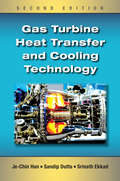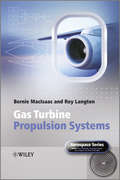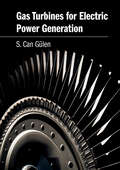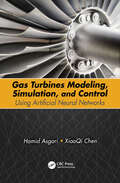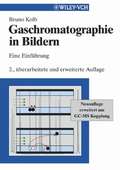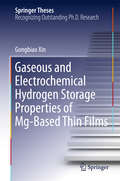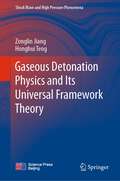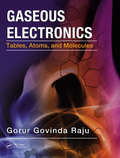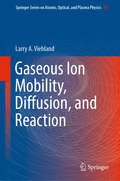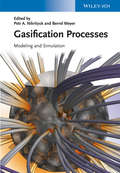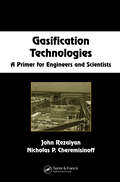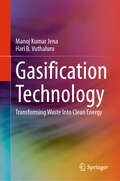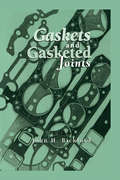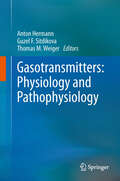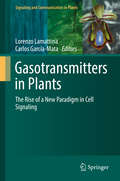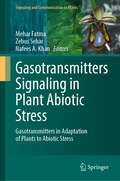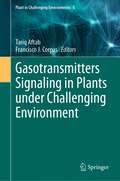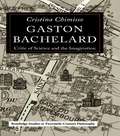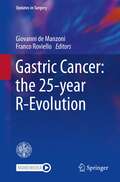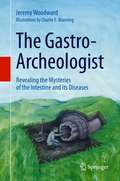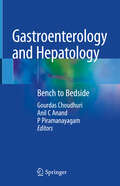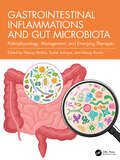- Table View
- List View
Gas Turbine Heat Transfer and Cooling Technology
by Je-Chin Han Sandip Dutta Srinath EkkadA comprehensive reference for engineers and researchers, this second edition focuses on gas turbine heat transfer issues and their associated cooling technologies for aircraft and land-based gas turbines. It provides information on state-of-the-art cooling technologies such as advanced turbine blade film cooling and internal cooling schemes. The book also offers updated experimental methods for gas turbine heat transfer and cooling research, as well as advanced computational models for gas turbine heat transfer and cooling performance predictions. The authors provide suggestions for future research within this technology and includes 800 illustrations to help clarify concepts and instruction.
Gas Turbine Propulsion Systems
by Bernie Macisaac Roy LangtonMajor changes in gas turbine design, especially in the design and complexity of engine control systems, have led to the need for an up to date, systems-oriented treatment of gas turbine propulsion. Pulling together all of the systems and subsystems associated with gas turbine engines in aircraft and marine applications, Gas Turbine Propulsion Systems discusses the latest developments in the field.Chapters include aircraft engine systems functional overview, marine propulsion systems, fuel control and power management systems, engine lubrication and scavenging systems, nacelle and ancillary systems, engine certification, unique engine systems and future developments in gas turbine propulsion systems. The authors also present examples of specific engines and applications.Written from a wholly practical perspective by two authors with long careers in the gas turbine & fuel systems industries, Gas Turbine Propulsion Systems provides an excellent resource for project and program managers in the gas turbine engine community, the aircraft OEM community, and tier 1 equipment suppliers in Europe and the United States. It also offers a useful reference for students and researchers in aerospace engineering.
Gas Turbines for Electric Power Generation
by S. Can GülenIn this essential reference, both students and practitioners in the field will find an accessible discussion of electric power generation with gas turbine power plants, using quantitative and qualitative tools. Beginning with a basic discussion of thermodynamics of gas turbine cycles from a second law perspective, the material goes on to cover with depth an analysis of the translation of the cycle to a final product, facilitating quick estimates. In order to provide readers with the knowledge they need to design turbines effectively, there are explanations of simple and combined cycle design considerations, and state-of-the-art, performance prediction and optimization techniques, as well as rules of thumb for design and off-design performance and operational flexibility, and simplified calculations for myriad design and off-design performance. The text also features an introduction to proper material selection, manufacturing techniques, and construction, maintenance, and operation of gas turbine power plants.
Gas Turbines Modeling, Simulation, and Control: Using Artificial Neural Networks
by Hamid AsgariGas Turbines Modeling, Simulation, and Control: Using Artificial Neural Networks provides new approaches and novel solutions to the modeling, simulation, and control of gas turbines (GTs) using artificial neural networks (ANNs). After delivering a brief introduction to GT performance and classification, the book:Outlines important criteria to consi
Gaschromatographie in Bildern: Eine Einführung
by Bruno KolbDie bew hrte Einf hrung in die Gaschromatographie von Bruno Kolb enth lt jetzt auch einen Abschnitt ber die GC-MS-Kopplung. Praktiker, Studenten und Auszubildende k nnen sich durch dieses Buch schnell und einfach mit der GC vertraut machen. Der Autor beschreibt neben den Grundlagen und Begriffen die Teile des GC-Systems (Injektionssysteme, Trenns ulen und Detektoren), die zahlreichen M glichkeiten der Probenaufgabe speziell f r Kapillars ulen, Betriebs-und Trennbedingungen, sowie ausf hrlich die quantitative Auswertung. Aus Rezensionen der ersten Auflage "Dieses didaktisch und graphisch gut gestaltete Buch kann den Anwendern der Kapillar-GC w rmstens empfohlen werden; es kann auch in der Ausbildung sehr gut eingesetzt werden." Chromatographia "Dem Autor ist es gelungen, ohne komplizierte Theorien zu beschreiben, in anschaulicher Weise pr zise ber die wesentlichen Grundlagen der GC zu informieren. Herausragend ist dabei die Gegen berstellung von verst ndlichen Abbildungen mit dem dazugeh rigen Text auf jeder Doppelseite des Buches. [...] Das Werk sollte deshalb in keinem GC-Labor fehlen und ist dem neuen Anwender oder den 'alten Hasen' u erst zu empfehlen." Lebensmittelchemie ber den Autor: Bruno Kolb war lange Jahre in der Perkin-Elmer Firmengruppe als Leiter der GC-Anwendung t tig und war massgeblich an der Entwicklung von GC-Detektoren und insbesondere der Headspace-Technik beteiligt. Er hat zahlreiche GC-Einf hrungs- und Anwendungskurse gegeben, ist Herausgeber und Autor mehrerer B cher sowie von ber 50 wissenschaftlichen und technischen Publikationen.
Gaseous and Electrochemical Hydrogen Storage Properties of Mg-Based Thin Films
by Gongbiao XinThis thesis introduces the preparation of a series of Mg-based thin films with different structures using magnetron sputtering, as well as the systematical investigation of their gaseous and electrochemical hydrogen storage properties under mild conditions. It reviews promising applications of Mg-based thin films in smart windows, hydrogen sensors and Ni-MH batteries, while also providing significant insights into research conducted on Mg-based hydrogen storage materials, especially the Mg-based films. Moreover, the unique experimental procedures and methods (including electric resistance, optical transmittance and electrochemical methods) used in this thesis will serve as a valuable reference for researchers in the field of Mg-based hydrogen storage films.
Gaseous Detonation Physics and Its Universal Framework Theory (Shock Wave and High Pressure Phenomena)
by Zonglin Jiang Honghui TengThis book highlights the theories and research progress in gaseous detonation research, and proposes a universal framework theory that overcomes the current research limitations. Gaseous detonation is an extremely fast type of combustion that propagates at supersonic speed in premixed combustible gas. Being self-sustaining and self-organizing with the unique nature of pressure gaining, gaseous detonation and its gas dynamics has been an interdisciplinary frontier for decades. The research of detonation enjoyed its early success from the development of the CJ theory and ZND modeling, but phenomenon is far from being understood quantitatively, and the development of theories to predict the three-dimensional cellular structure remains a formidable task, being essentially a problem in high-speed compressible reacting flow. This theory proposed by the authors’ research group breaks down the limitation of the one-dimensional steady flow hypothesis of the early theories, successfully correlating the propagation and initiation processes of gaseous detonation, and realizing the unified expression of the three-dimensional structure of cell detonation. The book and the proposed open framework is of high value for researchers in conventional applications such as coal mine explosions and chemical plant accidents, and state-of-the-art research fields such as supernova explosion, new aerospace propulsion engines, and detonation-driven hypersonic testing facilities. It is also a driving force for future research of detonation.
Gaseous Electronics: Tables, Atoms, and Molecules
by Gorur Govinda RajuWith the constant emergence of new research and application possibilities, gaseous electronics is more important than ever in disciplines including engineering (electrical, power, mechanical, electronics, and environmental), physics, and electronics. The first resource of its kind, Gaseous Electronics: Tables, Atoms, and Molecules fulfills the author’s vision of a stand-alone reference to condense 100 years of research on electron-neutral collision data into one easily searchable volume. It presents most—if not all—of the properly classified experimental results that scientists, researchers, and students require for a theoretical and practical understanding of collision properties and their impact. An unprecedented collection and analysis of electron neutral collision properties This book follows a new user-friendly format that enables readers to easily retrieve, analyze, and apply specific atomic/molecular information as needed. In his previous work, Gaseous Electronics: Theory and Practice, the author first explored electron–neutron interactions. To clarify the complex fundamental processes involved, he cited as much experimental data on atoms and molecules as limited space would allow. Completing that task, this handy reference more fully compiles essential revised data on more than 420 atoms and molecules, arranging it into easily digestible chapters, sections, and appendices. Analysis parameters include total scattering, ionization, excitation, attachment cross sections, ionization and attachment coefficients, attachment rates, and ion drift velocity. Some recent research areas in gaseous electronics include: Environmentally efficient and protective lighting devices Plasma research for power generation and space applications Medical applications (some involving skin treatment and healing) Written entirely in SI units, the book includes hundreds of tables, figures, and specially drawn charts, with data expressed in both tabular and graphical form. Each chapter stands independently and contains references for further research.
Gaseous Ion Mobility, Diffusion, and Reaction (Springer Series on Atomic, Optical, and Plasma Physics #105)
by Larry A. ViehlandThis book is about the drift, diffusion, and reaction of ions moving through gases under the influence of an external electric field, the gas temperature, and the number density. While this field was established late in the 19th century, experimental and theoretical studies of ion and electron swarms continue to be important in such varied fields as atomic and molecular physics, aeronomy and atmospheric chemistry, gaseous electronics, plasma processing, and laser physics. This book follows in the rigorous tradition of well-known older books on the subject, while at the same time providing a much-needed overview of modern developments with a focus on theory. Graduate students and researchers new to this field will find this book an indispensable guide, particularly those involved with ion mobility spectrometry and the use of ion transport coefficients to test and improve ab initio ion-neutral interaction potentials. Established researchers and academics will find in this book a modern companion to the classic references.
Gaseous radiation detectors
by Fabio SauliWidely used in high-energy and particle physics, gaseous radiation detectors are undergoing continuous development. The first part of this book provides a solid background for understanding the basic processes leading to the detection and tracking of charged particles, photons, and neutrons. Continuing then with the development of the multi-wire proportional chamber, the book describes the design and operation of successive generations of gas-based radiation detectors, as well as their use in experimental physics and other fields. Examples are provided of applications for complex events tracking, particle identification, and neutral radiation imaging. Limitations of the devices are discussed in detail. Including an extensive collection of data and references, this book is ideal for researchers and experimentalists in nuclear and particle physics.
Gashydrate – Eine Einführung in Grundlagenforschung und Anwendung
by Judith M. SchicksGashydrate, auch „brennendes Eis“ genannt, sind faszinierende, eisähnliche Feststoffe, die aus Wasser- und Gasmolekülen aufgebaut sind und weltweit an allen aktiven und passiven Kontinentalhängen und in Permafrostgebieten vorkommen. Doch ihr unauffälliges Erscheinungsbild täuscht: Die Einschlussverbindungen können beachtliche Mengen Methangas enthalten. Daher besteht einerseits die Hoffnung auf einen möglichen neuen Energieträger und andererseits die Sorge um eine nicht zu unterschätzende Quelle an klimaschädlichem Methangas. Gashydrate, hat die neueste Forschung gezeigt, bieten zudem in vielen Bereichen industrieller Anwendung eine durchaus vielversprechende Alternative zu konventionellen Verfahren.Das vorliegende Buch gibt eine Einführung in die physikalisch-chemischen Grundlagen der Hydratbildung und die Strukturen der Gashydratphasen. Basierend auf diesem grundlegenden Verständnis erklärt es die natürlichen Gashydratvorkommen und zeichnet mögliche Methoden des Abbaus und der Gewinnung von Methangas auf. Es beleuchtet Risiken, die von den Gashydratvorkommen in der Natur ausgehen könnten, und führt in die Möglichkeiten der Nutzung dieser Einschlussverbindungen in verschiedenen industriellen Anwendungsbereichen wie z.B. der Aufbereitung von Abwässern oder der Speicherung von Gasen ein.Zielgruppe dieser kompakten Einführung in die verschiedenen Aspekte der Gashydratforschung sind Studierende der Chemie und Geowissenschaften, Ingenieure, Techniker oder auch Wissenschaftler.
Gasification Processes
by Petr A. Nikrityuk Bernd MeyerBridging the gap between the well-known technological description of gasification and the underlying theoretical understanding, this book covers the latest numerical and semi-empirical models describing interphase phenomena in high-temperature conversion processes. Consequently, it focuses on the description of gas-particle reaction systems by state-of-the-art computational models in an integrated, unified form. Special attention is paid to understanding and modeling the interaction between individual coal particles and a surrounding hot gas, including heterogeneous and homogeneous chemical reactions inside the particle on the particle interface and near the interface between the solid and gas phases. While serving the needs of engineers involved in industrial research, development and design in the field of gasification technologies, this book's in-depth coverage makes it equally ideal for young and established researchers in the fields of thermal sciences and chemical engineering with a focus on heterogeneous and homogeneous reactions.
Gasification Technologies: A Primer for Engineers and Scientists (Chemical Industries)
by John Rezaiyan Nicholas P. CheremisinoffIn contrast to traditional combustion, gasification technologies offer the potential for converting coal and low or negative-value feedstocks, such as petroleum coke and various waste materials into usable energy sources or chemicals. With a growing number of companies operating and marketing systems based on gasification concepts worldwide, this b
Gasification Technology: Transforming Waste Into Clean Energy
by Manoj Kumar Jena Hari B. VuthaluruThis book examines the growing interest in gasification technology, which has become the primary route for effectively utilizing solid carbonaceous material for energy generation and syngas production. The thermochemical conversion of solids, including pyrolysis, combustion, and gasification, has become a primary method for extracting energy and value-added chemicals. However, gasification technology is the most efficient and economical way to utilize solid fuel. Understanding the gasification process and its diversified applications is essential for making gasification technology sustainable in the future. This book provides readers with an in-depth understanding of gasification technology, covering its past use, present scenario, and future outlook. Specifically, in an emerging world with the rapid advancement of science and technology, this book offers knowledge on the fundamentals, applications, and sustainable advancement of gasification technology covering a wide range of solid fuels. Gasification Technology: Transforming Waste Into Clean Energy provides early career researchers, engineers, and research and development scientists with a solid knowledge base on the fundamentals, industrial applications, and commercialization of gasification. The first book to cover all aspects of gasification technology; Examines the role and importance of gasification technology and the rise in global energy demand; Integrates insights into engineering applications and the advancement of gasification as a sustainable technology.
Gaskets and Gasketed Joints (Mechanical Engineering)
by John BickfordBringing together decades of research findings into a single, coherent source, this practical guide discusses industrial, automotive, and chemical gasket types and materials from selection, installation, and testing to applications and problem-solving and prevention methods. The coverage includes, but is not limited to, the complex mechanical and l
Gasotransmitters: Physiology and Pathophysiology
by Guzel F. Sitdikova Thomas M. Weiger Anton HermannSince the epochal discovery of the radical and highly toxic gas nitric oxide (NO) as a signaling molecule, two other no less toxic gases - carbon monoxide (CO) and hydrogen sulfide (H2S) - have been found to also be involved in a plethora of physiological and pathophysiological functions. The gases termed gasotransmitters play an increasingly important role in understanding how signalling into and between cells is modulated and fine-tuned. The advent of gasotransmitters has profoundly changed our way of thinking about biosynthesis, liberation, storage and action mechanisms in cellular signaling. In recent years an impressive amount of new data, distributed throughout the existing literature, has been generated. For this book the editors have recruited distinguished colleagues in the field to summarize and review important biological, pharmacological and medical functions and their implications, as well as methods for the detection of gasotransmitters.
Gasotransmitters in Plants
by Lorenzo Lamattina Carlos García-MataThis book describes the three gasotransmitters nitric oxide (NO), hydrogen sulphide (H2S) and carbon monoxide (CO) and their function as intracellular signalling molecules in plants. Common properties are shared by NO, H2S and CO: they are beneficial at low concentrations but hazardous in higher amounts; they are small molecules of gas; they can freely cross cell membranes; their effects do not rely on receptors; they are generated enzymatically and their production is regulated; their functions can be mimicked by exogenous application; and their cellular effects may or may not be mediated by second messengers, but have specific cellular and molecular targets. In plants, many aspects of the biology of gasotransmitters remain completely unknown and generate intriguing questions, which will be discussed in this book.
Gasotransmitters in Plants: The Rise of a New Paradigm in Cell Signaling (Signaling and Communication in Plants)
by Lorenzo Lamattina Carlos García-MataThis book describes the three gasotransmitters nitric oxide (NO), hydrogen sulphide (H2S) and carbon monoxide (CO) and their function as intracellular signalling molecules in plants. Common properties are shared by NO, H2S and CO: they are beneficial at low concentrations but hazardous in higher amounts; they are small molecules of gas; they can freely cross cell membranes; their effects do not rely on receptors; they are generated enzymatically and their production is regulated; their functions can be mimicked by exogenous application; and their cellular effects may or may not be mediated by second messengers, but have specific cellular and molecular targets.In plants, many aspects of the biology of gasotransmitters remain completely unknown and generate intriguing questions, which will be discussed in this book.
Gasotransmitters Signaling in Plant Abiotic Stress: Gasotransmitters in Adaptation of Plants to Abiotic Stress (Signaling and Communication in Plants)
by Mehar Fatma Zebus Sehar Nafees A. KhanThis book deals with the gasotransmitters signaling in redox reactions and homeostasis for the adaptation of plants to unfavorable abiotic stress environments. There are lots of interesting chapters in this book that cover both research and educational objectives. This book serves as a reference illustrated book for all who are interested in the regulation of gasotransmitters and redox homeostasis in agriculture. Maintenance of redox homeostasis strengthens the potentiality of plants to resist abiotic stress conditions through the enhanced antioxidant system and the subsequent impact on other signaling molecules. The book presents novel outcomes and implications in plant biology concerning the study of different types of gasotransmitters signaling such as nitric oxide (NO), ethylene, hydrogen sulfide (H2S), etc. under diverse abiotic stresses in one place. The chapters of the book discuss the recent progress and current perspectives on the role of gasotransmitters relevance to plant functions and adaptations to abiotic stresses, the influence of gasotransmitters on the physiology of plants with respect to abiotic stress tolerance, gasotransmitters and omics for abiotic stress tolerance, advancement in the biology of gasotransmitters in regulating salinity and drought stress response in plants, new insights of gasotransmitters and cellular redox homeostasis in plants and the chapter also deliberate the emerging role of gasotransmitters in regulating redox homeostasis for plant stress management. This book is the first comprehensive book covering all aspects and advancements in the biology of gasotransmitters in redox homeostasis conferring different abiotic stress tolerance, from which readers from all backgrounds can get benefitted. This book will appeal to researchers, students, scientific societies, agriculturists, etc.
Gasotransmitters Signaling in Plants under Challenging Environment (Plant in Challenging Environments #5)
by Tariq Aftab Francisco J. CorpasAbiotic stressors, such as drought, extreme temperatures, heavy metals, or high salinity, are causing huge crop losses worldwide. These abiotic stressors are expected to become more extreme, less predictable, and more widespread in the near future. The harm of abiotic stresses includes the disruption of cellular redox homeostasis, reactive oxygen species (ROS) production, and oxidative stress in the plant. Plants have different mechanisms to fight stress, and these mechanisms are responsible for maintaining the required homeostasis in plants. Research on gasotransmitters is rapidly expanding and knowledge regarding the potential of gasotransmitters in biology and medicine is accumulating. Over the past few decades, the roles of these signaling molecules, especially NO and H2S, have been extensively studied for their application in plants. Recently, the emissions of endogenous gasotransmitters in plants have been widely studied and analyzed, thereby providing information to facilitate our understanding of new gasotransmitters signaling pathways. Given the multidimensional role of these signaling molecules, research over the past decades in mitigating abiotic stresses in plant biology and from an agriculture point of view, we intend to bring forth a comprehensive volume “Gasotransmitters Signaling in Plants under Challenging Environment". We are hopeful that this comprehensive volume will furnish the requisite of all those who are working or have an interest in the proposed topic
Gaston Bachelard: Critic of Science and the Imagination (Routledge Studies in Twentieth-Century Philosophy #Vol. 9)
by Cristina ChimissoIn this new study, Cristina Chimisso explores the work of the French Philosopher of Science, Gaston Bachelard (1884-1962) by situating it within French cultural life of the first half of the century. The book is introduced by a study - based on an analysis of portraits and literary representations - of how Bachelard's admirers transformed him into the mythical image of the Philosopher, the Patriarch and the 'Teacher of Happiness'. Such a projected image is contrasted with Bachelard's own conception of philosophy and his personal pedagogical and moral ideas.This pedagogical orientation is a major feature of Bachelard's texts, and one which deepens our understanding of the main philosophical arguments. The primary thesis of the book is based on the examination of the French educational system of the time and of French philosophy taught in schools and conceived by contemporary philosophers. This approach also helps to explain Bachelard's reception of psychoanalysis and his mastery of modern literature. Gaston Bachelard: Critic of Science and the Imagination thus allows for a new reading of Bachelard's body of work, whilst at the same time providing an insight into twentieth century French culture.
Gastric Cancer: the 25-year R-Evolution (Updates in Surgery)
by Franco Roviello Giovanni De ManzoniTwenty-five years ago, a monograph on gastric cancer was published by the Italian Society of Surgery: that book is recognized as a milestone in the management of these tumors in Italy. Oncological and surgical knowledge in the field of gastric cancer have changed dramatically over the last 25 years. The aim of this book is to offer an essential update on current diagnostic approaches and optimal treatment strategies. It gives comprehensive information on gastric cancer not neglecting the basic sciences, which can shed light on the carcinogenesis mechanisms involved in this pathology. The principles of tailored and multimodal treatment are examined according to the latest guidelines with the aim of providing a valuable synopsis for clinicians. The book not only reviews what has changed in the field of gastric cancer over the past quarter century but also offers the reader a glimpse of the future by describing the ongoing surgical and oncological trials which focus on new treatment frontiers such as immunotherapy and target therapy. It also seeks to incorporate the latest discoveries based on molecular classifications. Further, the book reflects the findings and experiences of Italian experts belonging to the GIRCG (Italian Research Group for Gastric Cancer) and will offer an excellent guide for oncological surgeons in their daily practice of caring for patients affected by gastric cancer.
The Gastro-Archeologist: Revealing the Mysteries of the Intestine and its Diseases
by Jeremy WoodwardIn order to understand common conditions such as coeliac disease and Crohn’s disease, one must view the gut in its evolutionary context. This is the novel approach to the gut and its diseases that is adopted in this book. The first part tells the story of the evolution of the gut itself – why it came about and how it has influenced the evolution of animals ever since. The second part focuses on the evolution of immunity and how the layers of immune mechanisms are retained in the gut, resembling the strata revealed in an archeological dig. The final part, ‘The Gastro-Archeologist’, ties the first two together and highlights how understanding the gut and immune system in their evolutionary context can help us understand diseases affecting them.Ambitious in its scope but telling a unique story from a refreshingly novel perspective, the book offers an informative and enjoyable read. As the story of the gut, immunity and disease unfolds, the author aims to endow readers with the same sense of awe and excitement that the subject evokes in him. Difficult concepts are illustrated using simple and colourful analogies, and the main content is supplemented with anecdotes and unusual and amusing facts throughout the book. The book is intended for anyone with an interest in the gut, its immunity and diseases, ranging from school and college biology and biomedical students, to professionals working in the field, and to patients suffering from intestinal diseases who want to understand more about their conditions.
Gastroenterology and Hepatology: Bench to Bedside
by Gourdas Choudhuri Anil C Anand P PiramanayagamThe book aims to be a handy compendium to the very voluminous texts of gastroenterology and hepatology existing in the knowledge market and provides the reader with an easy understanding of the bench knowledge (basic sciences) as they apply to bedside practice (clinical gastroenterology). With introduction and contributions from Prof Eamon Quigley, Former president of World Gastroenterology Organization and American College of Gastroenterology, the book covers the recent advances in the basic sciences that form an important pillar of the knowledge, thereby linking basic sciences such as anatomy, physiology, biochemistry, molecular medicine, etc. to clinical conditions, diseases and new therapeutic approaches in gastroenterology and hepatology. The book is written in a simple easy to read format, with a lot of diagrams and flowcharts, making it a handy guide. It also discusses in-depth about very common clinical conditions encountered in hospital settings such as ulcerative colitis, pseudomembranous colitis, colonic cancer, amebiasis, and various other syndromes and diseases. This book is a useful read for fellows and trainees in Gastroenterology and Hepatology, as well as gastroenterologists, hepatologists and physicians interested in digestive disorders.
Gastrointestinal Inflammations and Gut Microbiota: Pathophysiology, Management, and Emerging Therapies
by Anoop Kumar Neeraj Mishra Sumel AshiqueThis book offers a comprehensive and multi-faceted examination of gastrointestinal inflammations, discussing factors that impact gut health. The initial chapters establish a foundational understanding of gastrointestinal inflammations and the critical role of the gut microbiota. The book then delves into the complex pathophysiology and various risk factors associated with these conditions, offering insights into the latest diagnostic, screening, and prevention techniques. It explores the dynamic interactions between the gut and the brain as well as the biochemical interplays involving short-chain fatty acids, reactive oxygen species, and superoxide dismutases. Additionally, the book thoroughly discusses the impact of genetics on gastrointestinal health, the interactions between antibiotics and gut microbiota, and the pivotal role of the immune system in inflammation. It highlights advancements in diagnostic technologies and gut microbiota-based strategies, along with the use of nanoparticles in treatment. The book also examines the psychological aspects associated with gastrointestinal inflammations, emphasizing the importance of mental health for physical well-being. It assesses the potential of functional foods, various types of nanocarriers, and plant-based bioactives in managing gastrointestinal inflammations. As such, this book is primarily intended for researchers and students in the fields of gastroenterology and microbiology.Key Features: Provides an extensive overview of gastrointestinal inflammations, starting from the basic concepts of the gut microbiota to complex pathophysiological aspects Delves into the latest advancements in diagnostic, screening, and prevention techniques, highlighting cutting-edge technologies and approaches in gastroenterology Explores the role of the immune system and the impact of genetics and diet on gastrointestinal health Examines use of probiotics, prebiotics, postbiotics, and various nanotechnology-based approaches for gastrointestinal inflammation management Emphasis on the psychological factors associated with gastrointestinal inflammations
